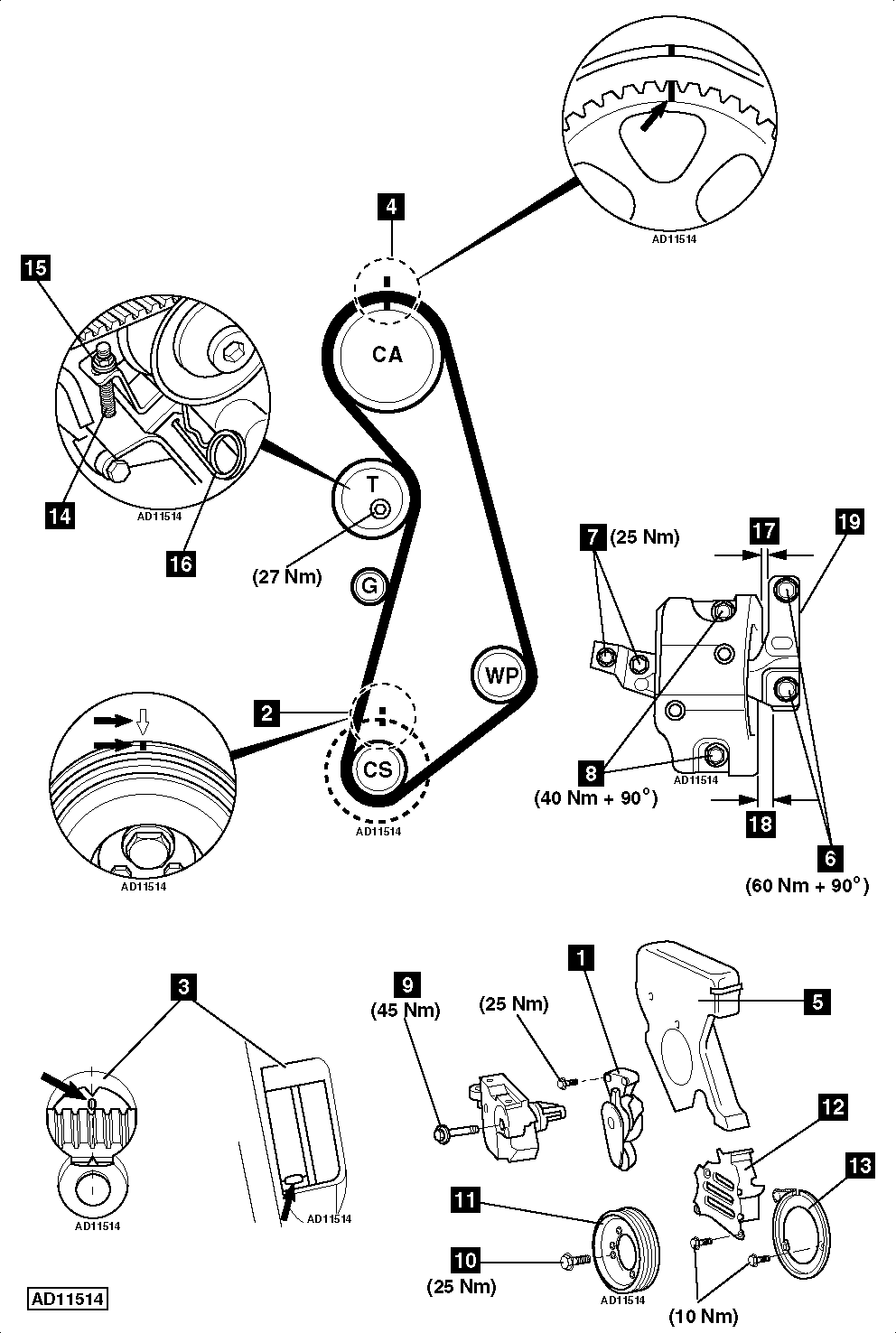Replacement Interval Guide
- Volkswagen recommend:
- Check at the first 60,000 miles and then every 20,000 miles (replace if necessary).
- Replacement every 120,000 miles (tensioner pulley must also be replaced).
NOTE: Volkswagen UK recommend the timing belt is replaced every 4 years if the replacement mileage is not reached.
- The previous use and service history of the vehicle must always be taken into account.
Check For Engine Damage
CAUTION: This engine has been identified as an INTERFERENCE engine in which the possibility of valve-to-piston damage in the event of a timing belt failure is MOST LIKELY to occur. A compression check of all cylinders should be performed before removing the cylinder head.
Repair Times – hrs
| Remove & install | 2,20 |
Special Tools
- 1 x M5 x 55 mm stud and nut.
Special Precautions
- Disconnect battery earth lead.
- DO NOT turn crankshaft or camshaft when timing belt removed.
- Remove spark plugs to ease turning engine.
- Turn engine in normal direction of rotation (unless otherwise stated).
- DO NOT turn engine via camshaft or other sprockets.
- Observe all tightening torques.

Removal
- Raise and support front of vehicle.
- Remove:
- Engine upper cover.
- RH engine undershield.
- Golf/Bora: RH headlamp.
- Intercooler to turbocharger hose.
- Auxiliary drive belt.
- Auxiliary drive belt tensioner [1] .
- Turn crankshaft to TDC on No.1 cylinder.
- Ensure timing marks aligned [2] or [3] .
- Remove:
- Coolant expansion tank. DO NOT disconnect hoses.
- PAS reservoir. DO NOT disconnect hoses.
- Fuel vapour hose from charcoal canister to throttle body.
- Timing belt upper cover [5] .
- Ensure camshaft sprocket timing marks aligned [4] .
- Support engine.
- Remove:
- RH engine mounting bolts [6] , [7] & [8] .
- RH engine mounting.
- Engine mounting bracket bolts [9] .
- Engine mounting bracket.
- Crankshaft pulley bolts [10] .
- Crankshaft pulley [11] .
- Timing belt centre cover [12] .
- Timing belt lower cover [13] .
- Insert M5 stud into tensioner [14] .
- Fit nut and washer to stud [15] . Tighten nut sufficiently to allow a suitable locking pin to be inserted [16] .
NOTE: DO NOT overtighten nut.
- Remove timing belt.
NOTE: Mark direction of rotation on belt with chalk if belt is to be reused.
Installation
- Ensure timing marks aligned [3] & [4] .
- Fit timing belt in following order:
- Crankshaft sprocket.
- Water pump sprocket.
- Tensioner pulley.
- Camshaft sprocket.
NOTE: Ensure belt is taut between sprockets on non-tensioned side.
- Remove locking pin [16] .
- Remove nut and stud [14] & [15] .
- Turn crankshaft two turns clockwise. Ensure timing marks aligned [3] & [4] .
- Fit engine mounting bracket.
- Tighten engine mounting bracket bolts to 45 Nm [9] .
- Install:
- Timing belt lower cover [13] .
- Crankshaft pulley [11] .
- Crankshaft pulley bolts [10] .
- Tighten crankshaft pulley bolts [10] . Tightening torque: 25 Nm.
- Fit engine mounting.
- Tighten:
- Engine mounting bolts [8] . Tightening torque: 40 Nm + 90°. Use new bolts.
- Engine mounting bolts [7] . Tightening torque: 25 Nm.
- Engine mounting bolts [6] . Tightening torque: 60 Nm + 90°. Use new bolts.
- Check engine mounting alignment:
- Engine mounting clearance: 14 mm [17] .
- Engine mounting clearance: 10 mm minimum [18] .
- Ensure engine mounting bolts [6] aligned with edge of mounting [19] .
- Install components in reverse order of removal.